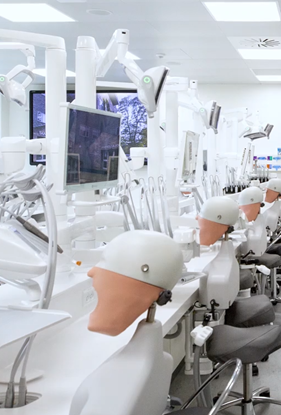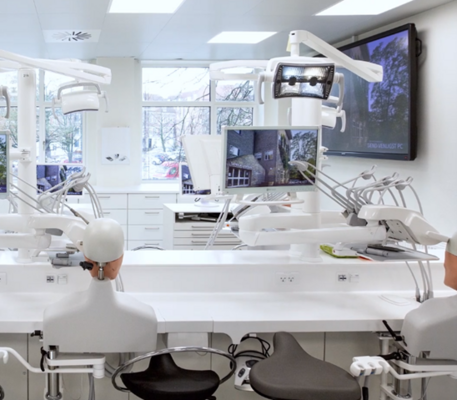The activity gives students practical experience with the procedure for a lower third molar removal by practicing on a model in a phantom clinic. At their workstations, the students have monitors where they can play a video of the instructor performing the same procedure.
Students require sufficient knowledge to undertake oral surgery, and therefore the practical sessions need to provide adequate training to bridge the gap between practice and reality. Currently, the students undertake a practical session for the removal of a lower third molar on a plaster model, placed in a phantom head (picture 1).
In the past they have been shown the procedure by dividing into smaller groups and observing a clinician undertake the practical first. The group sizes to observe a clinician can vary depending on how many clinicians are available, and this can make it difficult when groups sizes are large and only a few clinicians are available - especially due to the limited size of the oral cavity.
The students will need to have understood the intended procedure, as they will be carrying it out on real patients only a few weeks later. Therefore, a demonstration should allow all students to see the procedure, as well as provide an in-depth learning experience.
The students read the relevant book chapters before class, so that they become familiar with the procedure. In earlier sessions, they have already had several lectures on the instrumentation and techniques that will be used, and thus, the out-of-class activity serves as a “refresher”.
Presentation by the instructor: When in-class, the students will be sat by individual monitors. The teacher provides a short 30-minute lecture on the technique and instruments used, which can be viewed on the monitors (picture 2). The lecture provides the basis for the exercise and allows students with queries from their reading to address their concerns. In addition, it provides repetition of the subject matter to hasten and deepen the engagement process.


Following, the teacher performs a live lower third molar removal on a model (which is identical to the one student use), whilst a camera records, and the video is displayed on the students’ monitors. A live demonstration aids in student learning and confidence and the use of a camera will allow all students to have the same and adequate view.
The teacher talks through each step of the demonstration, and all students can ask questions along the way. Hence, this approach allows for a live and blended method, without disadvantaging any individual that may not, otherwise, have been able to see.
This should all give the students the best possible preparation before attempting to perform the surgery on their own models.
Read more about the use of video in class.
Relevant book chapters
Practical models
Video monitors
Students view each step undertaken in the procedure, as well the inside of the mouth equally from the screens.
Initial lecture
Live answers to queries
A recorded video to review
The demonstration can be recorded and shown afterwards in the classroom.
The effects of the activity have been evaluated by providing students with evaluation forms, as well as observation in-class.
The live demonstration via a camera has worked very well and the feedback was positive. It was found that students opted for this option rather than viewing the procedure over the shoulder of the operator.
The students verbally said that the camera was a better option than all standing next to the operator, as they could easily see the operating field on their monitor and therefore all were exposed to the same experience. As the camera had a zoom option, they felt that they had a better and closer view than would have been the case otherwise.
Overall, the feedback was positive for both days, however within the written component of the feedback for day 2 (the day where the camera and monitors were used), 47% of students specifically mentioned the demonstration as the strength of the day, in comparison to 6% on the day before (where students had to observe the procedure over the shoulder of an operator).
It could be an option to provide a recorded demonstration prior to the seminar, so the students will have some familiarity and thus support their in-class activities with their out-of-class activities even further.
A potential method for evaluation of the students understanding, as well as ensure student activation, could be to play a recorded demonstration of the procedure without commentary, and allow the student to explain what is happening and the steps being undertaken.